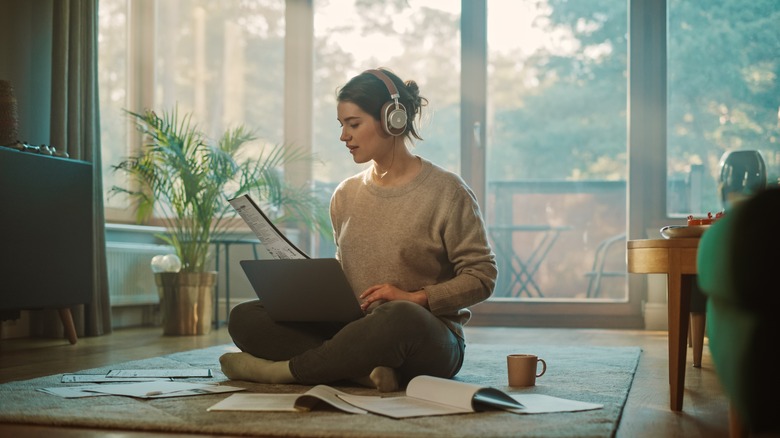Sitting On The Floor Could Be Your Ticket To Better Posture
Remote work comes with its benefits — one of the main ones being flexibility. That flexibility isn't only work task-related either. You can choose the temperature of your environment, the type of snacks stocked in the pantry, and where you work. Additionally, you can choose how you sit. Maybe you've invested in a traditional office chair, you've hopped on the standing desk trend, or you've replaced your chair with a yoga ball. You might have ditched the desk altogether and worked from your bed or couch. Regardless of where you work from now, adding some "floor time" could possibly bring about some unexpected health benefits — including mobility and increased blood flow.
"Floor time" is a TikTok trend that essentially encourages people to spend time working from the floor (as opposed to sitting in a chair). Some chiropractors and health professionals even encourage it. The action, according to the trend, can be a great method and reason to fix your posture. It can improve flexibility and longevity. While simple to incorporate — especially for those working remotely — there are some tips to ensure you reap the benefits and avoid back or hip pain.
Incorporating floor time into your daily routine
Chairs (and sitting in them) can be considered a symbol of Westernization. Unsurprisingly, in the West, chairs are commonplace, and an assumption for office spaces. In various cultures around the world, however, chairs aren't the default. Instead, people will often squat, kneel or sit. When you sit all day, or in a single position for an extended amount of time, you can develop health issues. These include back and hip pain, or signs of lumbar kyphosis — which causes the back to appear especially rounded. If done properly though, sitting on the floor can help improve your posture — and provide multiple other health benefits as well.
Incorporating "floor time" into your daily routine can be simple. Starting off with small doses of sitting cross-legged and gradually increasing the length of time is a good place to start. "Sitting on the floor helps to prevent slouching, as your lower back is naturally pulled slightly into a supported position when you are sitting with your legs crossed," Louisiana-based chiropractor Matthew Cavanaugh, D.C., told Health. "This helps to keep your core muscles engaged and prevents aches and pains that can come from sitting in an improper position."
The surface you sit on matters. Sitting on a rug, carpet, yoga mat, cushion, or yoga block can provide extra support. Leaning against a sturdy surface such as a wall can also help prevent slouching.
Pros and cons of sitting on the floor
While there's not much research out there looking into the pros and cons of sitting on the floor, there is the sitting-rising-test, SRT, which looks at the correlation between how easily you can go from sitting on the floor to standing on your feet and your longevity. The more ease you have when getting up, the greater your longevity. Regularly sitting on the floor can be a great way to practice — and, as a result, possibly improve your longevity.
In addition to improving posture and increasing blood flow, mobility, and flexibility, sitting cross-legged can help relieve tension, improve bowel movement, and stretch and strengthen muscles. Yet, sitting on the floor isn't a cure-all and comes with some risks. Ensuring that you're sitting properly may help ease back and hip pain. However, some may still experience it — especially those who've had back surgery. Those already experiencing lower back pain should avoid sitting on the floor and instead opt for a supportive chair.
It's crucial to listen to your body. Some may come to love "floor time" and see an improvement in posture and flexibility over time. Others may find that it exacerbates their back pain. Figuring out what works best for you and making sure that you're sitting properly is how you can best take advantage of "floor time."


